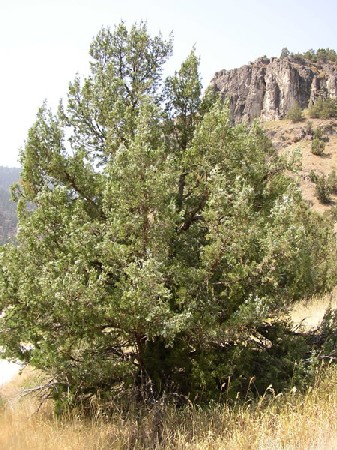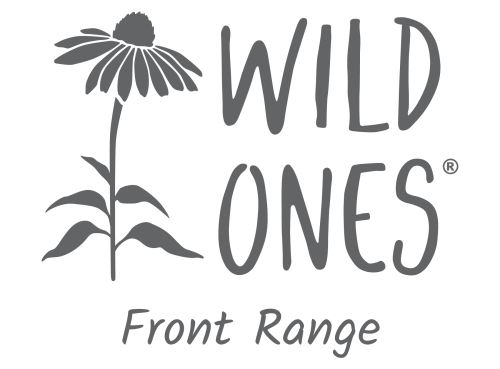By Karen Vanderwall and Kristine Johnson

I know, just the thought of planting a juniper (Juniperus scopulorum) on purpose in or near your garden of all places seems unlikely–or at least way down on the list of interesting plants you’re “pining” for. But you may want to give the humble native juniper some consideration. Juniperus scopulorum, also known as Rocky Mountain, Western, Colorado Red Cedar or Western Juniper, is an important native conifer that provides habitat for many species of wildlife. It also acts as a larval host and furnishes excellent erosion control, as it often grows on hillsides.
In their native environment, junipers are found in the western part of the Great Plains and through the Rocky Mountains where they often grow on prairie hillsides, dry rocky outcrops, exposed bluffs, butte tops and open forests. They range in size from shrub to tree. A sister species, one-seed juniper (Juniperus monosperma) is a major component of the piñon-juniper woodlands, which dominate western Colorado.
Native plant gardeners may consider the Rocky Mountain juniper a graceful evergreen with a columnar or round shape and drooping blue-green foliage. Its growth form is that of a tree or shrub. Like all evergreens, it provides year-round structure and habitat in the garden. Junipers have flat, fan-like “leaves” and produce dark blue fruit in the fall, usually between September and October. The pretty reddish gray bark can appear as if it is shedding. The USDA’s hardiness zones for this plant are 3-7. In addition to the amazing wildlife benefits, this juniper is very tough and an all-around workhorse.

Some fun facts about this juniper are that many people confuse this tree with cedar, which is a member of the pine family. Junipers have even been used for cedar chests! However, junipers are members of the cypress family. Those beautiful blue berrylike fruits—that we all love about junipers—are not berries at all but are actually cones—yes, junipers are conifers! You may notice that the cones are not on all of the trees. Mostly, Rocky Mountain junipers grow as single-species plants (they are dioecious, with separate male and female specimens). The berrylike cones are female, and the very small pollen cones are male.
I also love learning why plant species are given the names they have. For example, scopulorum is latin for “of rocky cliffs,” which is the type of habitat where you will find junipers.

For us, the most important facts about Juniperius scopulorum are related to how beneficial the species is to wildlife and pollinators. The leaves and twigs are used by mule deer and elk in the winter for food and cover. Many bird species, such as the cedar waxwing, evening grosbeaks, grouse, Townsend’s solitaire and wild turkeys, eat the berrylike cones. The branches provide shelter and nesting sites for chipping sparrows, juncos towhees, warblers and many more.
Uniquely, the Rocky Mountain juniper is the host plant for the uncommon juniper hairstreak butterfly. The larvae of this iridescent olive-green butterfly eat the leaves of the Rocky Mountain juniper and then overwinter on or near it as pupae. The adult male butterflies are usually found on or around the trees waiting for females. Exciting!
Junipers get a lot of negative attention because of their flammability. Landscaping in Colorado went through a phase of using (mostly non-native) decorative shrub junipers as ground covers to fill in large areas and as foundational plantings right next to homes. Now, in the era of climate change and increased fire risk, we know that in high-risk areas (wildland urban interfaces and other areas), careful plant choice close to homes is wise. In high-risk areas:
- Do not plant junipers and other conifers in the zone 0 to 30 feet from structures.
- Between 30 to 100 feet from structures, plant non-flammable or low flammable plants (this excludes all evergreen conifers).
- Plant so the crowns of trees are 30 feet apart.
- Remove the lower limbs of trees (which can make junipers look pretty awful).
Well-spaced conifers, including junipers, are fine beyond 100 feet from structures. (This may be your neighbor’s yard, in which case, disregard this.) While this is discouraging news for our friends living in wildland urban interfaces and other high risk areas, knowledge is power. We encourage you to focus on all fire safety information, including that about landscaping, while realizing that many beloved species, junipers among them, may not be appropriate in all home landscapes. Check out these firewise resources:
Fire Resistance of Plants Master Database
Low Flammability Landscape Plants, CSU Extension
Low Flammability Landscape Plants, CSU Extension pdf
Wildland Fire Preparedness Guide, City of Boulder
References:
Plant Database, Lady Bird Johnson Wildflower Center, 2023-03-23
Angel, Leslie (2005). Butterflies of Rocky Mountain National Park : an observer’s guide. Boulder, Colorado: Johnson Books. pp. 68–69, 230. ISBN 978-1-55566-351-3. Retrieved 20 December 2024.
Scher, Janette S. (2002). “Juniperus scopulorum“. Fire Effects Information System. U.S. Department of Agriculture, Forest Service, Rocky Mountain Research Station, Fire Sciences Laboratory. Archived from the original on 13 March 2023. Retrieved 20 December 2024.
Sieg, Carolyn Hull (1991). Rocky Mountain Juniper Woodlands: year-round avian habitat. Fort Collins, Colorado: U.S. Department of Agriculture, Forest Service, Rocky Mountain Forest and Range Experiment Station. Retrieved 20 December 2024.
Stevens, Michelle. Rocky Mountain Juniper. Plant Guide. Contributed By: USDA, NRCS, National Plant Data Center, NRCS, USDA. Retrieved 20 December 2024.
